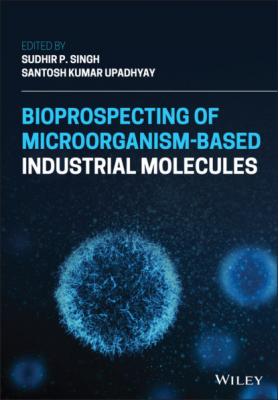Bioprospecting of Microorganism-Based Industrial Molecules. Группа авторов
Читать онлайн.| Название | Bioprospecting of Microorganism-Based Industrial Molecules |
|---|---|
| Автор произведения | Группа авторов |
| Жанр | Биология |
| Серия | |
| Издательство | Биология |
| Год выпуска | 0 |
| isbn | 9781119717263 |
| Microbial gum | Application | Properties | References |
|---|---|---|---|
| Xanthan | Food Hydrocolloid | Viscosifier, stabilizer and emulsifier | [28] |
| Xanthan | Fat replacer | Viscosifier, and emulsifier | [29] |
| Gellan | Food Hydrocolloid | Gelling, suspending and stabilizing agent | [31] |
| Welan | Cement technology | Viscosifier | [3] |
| Welan | Oil drilling industries | Viscosifier | [3] |
| Rhamsan | Food Hydrocolloid | Viscosifier, high salt tolerance | [21] |
| Diutan | Cement technology | Viscosifier | [22] |
| Pullulan | Food Additive | Prebiotic | [35, 39] |
| Pullulan | Edible films, capsule shells and tablet coatings | Non‐toxic, film‐forming gels | [12] |
| Curdlan | Fat replacer | Viscosifier, ability to form thermo‐irreversible gel | [6] |
| Levan | Sweeting agent | Sugar containing viscosifier | [12] |
| Levan | Cosmetic products | Moisturizing, cell proliferation and anti‐inflammatory effects | [12] |
| Dextran | Food Hydrocolloid | Viscosifier, stabilizer and emulsifier | [26] |
| Xanthan and curdlan | Edible film in food packaging | Excellent miscibility and high tensile strength | [40] |
| Gellan | Hydrogel for bone regeneration | Bio‐compatible, bio‐degradable, non‐toxic | [41] |
| Pullulan and hyaluronic acid | Hydrogel for wound healing | Bio‐compatible, bio‐degradable, non‐toxic | [42] |
| Xanthan and welan | Nanoemulsions for delivery of bioactive compounds | Emulsifier | [43] |
3.6.1 Food Applications
As explained in the previous sections, many microbial gums have properties pertaining to food applications by being used as food hydrocolloids, emulsifiers, stabilizers, and gelling agents. In recent times, the application of microbial gums in food is diversified to a large extent. Prebiotic properties of pullulan have been utilized to make prebiotic bread. The addition of 2% pullulan showed promising result in sensory evaluations and displayed resistance to gastric juice. Pullulan showed higher prebiotic activity score (PAS) than other microbial gums like xanthan and gellan [39].
Studies on the impact of different gums in goat milk were conducted by accessing the textural and microbial properties of yogurt using xanthan, carrageenan, locust bean gum, gaur gum, and modified starches. The yogurt samples containing both xanthan and locust bean gum showed superior properties than the control sample, such as enhanced firmness, consistency, cohesiveness, and viscosity. The gums supplemented also showed bifidogenic activity enhancing the growth of Bifidobacterium animalis Bb12 [4].
In recent times, dextran from LAB genus Weissella has been utilized as a natural food hydrocolloid to prepare high‐fiber containing bread and gluten‐free bread [26]. In situ dextran production by Weissella confusa A16 in wholegrain sorghum bread containing 50% wheat flour resulted in the improved texture of the bread. In situ production by Weissella confusa A16 resulted in 0.56% dextran of bread weight. It helped in masking undesirable flavors of wholegrain bread [44].
Microbial gums have been recently utilized as edible films in food technology resulting in a nontoxic, biocompatible, and biodegradable alternative to synthetic plastic films. The functional properties of the edible films can be enhanced further by the blending of microbial gums with lipids, hydrocolloids, or reinforcement agents [2]. Edible films composed of cassava starch and different microbial gums like xanthan, gellan, and pullulan were obtained by casting, and various properties were evaluated. Gellan gum was found to be most suitable for this purpose with the concentration of 10–20% blend by enhancing the film strength and resistance to breaking and preserving films against starch retrogradation throughout the storage time and reducing the moisture sorption capacity of starch films while reducing water vapor permeability [45]. Edible film blends were prepared using different ratios of xanthan and curdlan. Blends of xanthan and curdlan in a ratio of 5:5 and 4:6 showed excellent miscibility and high tensile strength. It confirmed that the blends of edible film have great potential as food packaging material [40].
Microbeads from whey protein isolate and gellan gum were used as a carrier for bioactive compounds of flaxseed. The encapsulation of flaxseed oil (15%) resulted in a controlled release only in the small intestine and was able to pass the gastric barriers without any modifications. This directed release of the bioactive compound can improve their bioavailability and functionality [46].
3.6.2 Biomedical Applications
Among all the microbial gums used today, dextran is the first example of a microbial biopolymer to be used for pharmaceutical applications. It was used as a plasma volume expander since 1953 [47]. In recent times, hydrogel form of microbial gums has been used for a different biomedical purpose. Hydrogels are 3D scaffolds made from biomaterials, which provide a suitable microenvironment for tissue engineering and regenerative medicine. The basic advantages of hydrogels are that they are biocompatible, biodegradable, nontoxic, and have flexibility similar to human tissue. Microbial gums like xanthan, gellan, and dextran are mostly used for hydrogel preparation. Composite hydrogels or blends using two or more gums are used for biomedical applications with superior properties. Some applications of microbial gums used as hydrogels are seen in tissue engineering used as scaffolds, in wound healing as skin barricade due to their adhesive properties, and in drug delivery [1].
Gellan gum hydrogel with magnesium‐enriched calcium carbonate, calcium carbonate, and magnesium carbonate using urease‐mediated mineralization was used for bone regeneration application [41]. Bioactive molecule curcumin was
